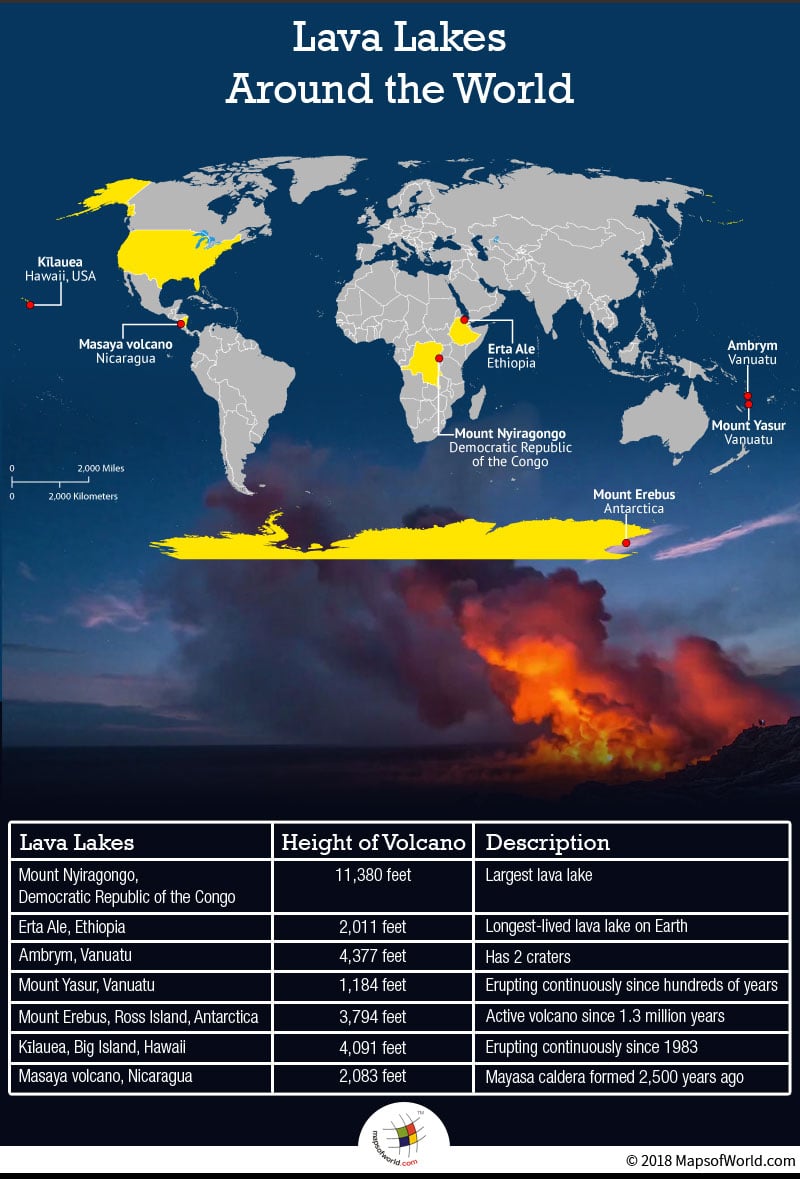Where are Lava Lakes Located?

We have heard about volcanic eruptions, seen the disasters on geographic channels or even in movies. What many of us are unaware of, is the existence of lava lakes in the Real World. As the name itself suggests, Lava lakes exist as massive volumes of burning, bright, molten lava contained inside a crater, volcanic vent or depression. These are wholly, or partly molten – and sometimes are even solidified. The formation occurs after the eruption of one or more volcanic vents, and the molten lava either collects in its vent itself, or flows down further to fill up in a depression. Generally these lakes are temporarily formed, but for them to thrive longer, it needs a heat source that continues to feed enough energy.
Here are few of the famous existing lava lakes around the world:
-
Mount Nyiragongo, Democratic Republic of the Congo
The world’s largest lava lake is at Mount Nyiragongo, near Congo’s border with Rwanda. This very active volcano is at a high elevation, 11,380 ft in the Virunga Mountains. The crater where the lake is formed, has a width of 1.2 miles. The maximum elevation of the lava lake was recorded at whopping 10,660 ft – which occurred before the January 1977 eruption. The lava lake was around 2,000 ft deep. On January 17th, 2002, a major eruption occurred which led to the displacement of 500,000 people when the lake poured out 12.4 miles away, to the city of Goma.
-
Erta Ale, Ethiopia
The most active volcano in Ethiopia – ‘Erta Ale’ itself translates to ‘smoking mountain’. It is located in the Afar depression which is a badlands desert area in the northeastern Ethiopia. Elevated at 2,011 feet, the volcano has two active lava lakes. The lava lake here has existed since the beginning of the 20th century, and at present, is the longest-lived lava lake on Earth. There are quite frequent eruptions in the volcano – the last being in January 2017. One massive eruption of 2005, had killed 250 head of livestock, and thousands of inhabited residents in nearby regions had to move.
-
Ambrym, Vanuatu
In the archipelago of Vanuatu, is a volcanic island Ambrym, located in Malampa province. This active volcano has a 7.4 mile-wide caldera, formed after many plinian explosions around 50 AD. Lava lakes are formed inside two craters named: Benbow and Marum. In fact, the lava lakes present in the Marum Crater has been shown in the Google Street View since March, 2017.
-
Mount Yasur, Vanuatu
1,184 ft above sea level is Mount Yasur – a volcano on Tanna Island, Vanuatu. It has been erupting continuously since hundreds of years. It is a major tourist attraction because it is easier to reach. In fact, the glow of the stratovolcano even made James Cook explore the area, on his first European voyage in 1774.
-
Mount Erebus, Ross Island, Antarctica
The second-highest volcano in Antarctica – Mount Erebus, with an elevation of 3,794 feet has been active for 1.3 million years. Several craters are located at the summit, including Side Crater. The long lived lava lake in the coldest region on Earth, huffs and puffs steam, and even aims lava bombs (flying blobs of molten rock) at the explorers who reach the slopes to unravel mysteries.
-
Kīlauea, Big Island, Hawaii
Currently active shield volcano in the Hawaiian Islands, Kīlauea is about 300,000 to 600,000 years old. Kīlauea has a recently built, large caldera at its summit and two lava lakes are persistent. One is formed in the Halemaʻumaʻu vent cavity and another in Puʻu ʻŌʻō cone. The volcano has been erupting continuously since 1983, however it was only recently, in May, 2018 – that the lava lakes of the two cavities disappeared. It was because of increased activity in the east rift zone of Kīlauea, but scientists and researchers are fixated on the belief that it will re-appear soon.
-
Masaya volcano, Nicaragua
Masaya volcano is situated in Nicaragua, and has a bit of complex structure. It consists of calderas and craters nested together. Las Sierras shield volcano and caldera is the largest. A basaltic ignimbrite eruption led to the formation of Masaya caldera about 2,500 years ago. The boiling lava lake, located in the Santiago crater of the Masaya volcano, has even attracted adventurers from around the world. However, in the recent years the volcano has been witnessing small eruptive episodes, which leads to the formation of lava lakes occasionally and for temporary duration.
Know More:
